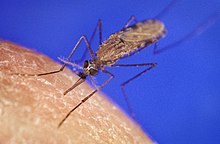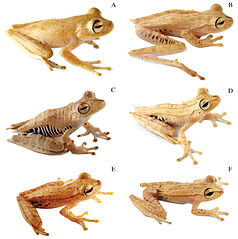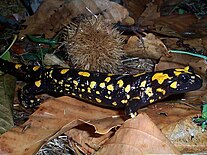This article is about a group of very similar species. For "species-group names" in zoological nomenclature, see International Code of Zoological Nomenclature. For individuals of different species grouping together, see Mutualism (biology)#Service-service relationships.
"Cryptic species" redirects here. For the principles of hiding, see Crypsis. For a supposed creature whose existence is not scientifically recognized, see Cryptid.
"Physiologic race" redirects here. For the mycology and phytopathology informal classification, see Race (biology) § Physiological race.
Two or more taxa once considered conspecific (of the same species) may later be subdivided into infraspecific taxa (taxa within a species, such as bacterial strains or plant varieties but this is not a species complex.
A species complex is in most cases a monophyletic group with a common ancestor, although there are exceptions. It may represent an early stage after speciation, but may also have been separated for a long time period without evolving morphological differences. Hybrid speciation can be a component in the evolution of a species complex.
Species complexes exist in all groups of organisms. They are identified by the rigorous study of differences between individual species, making use of minute morphological details, tests of reproductive isolation or DNA-based methods such as molecular phylogenetics or DNA barcoding. The existence of extremely similar species may cause local and global species diversity to be underestimated. Recognizing similar but distinct species is important for disease and pest controls and in conservation biology, although drawing dividing lines between species can be inherently difficult.
Definition
A species complex is typically considered as a group of close, but distinct species. Obviously, the concept is closely tied to the definition of a species. Modern biology understands a species as "separately evolving metapopulation lineage but acknowledges that the criteria to delimit species. may depend on the group studied. Thus, many species defined traditionally, based only on morphological similarity, have been found to comprise several distinct species when other criteria, such as genetic differentiation or reproductive isolation were applied.
At least six treefrog species make up the Hypsiboas calcaratus–fasciatus species complex.
A more restricted use applies the term to close species between which hybridisation occurred or is occurring, leading to intermediate forms and blurred species boundaries.
The fly agaric comprises several cryptic species, as shown by genetic data.
The African forest elephant (shown) is the bush elephant sibling species.
Mbuna cichlids form a species flock in Lake Malawi.
Included Concept
Several terms are used synonymously for a species complex, but some of them may also have slightly different, or more narrow meanings. In the nomenclature codes, of zoology and bacteriology, no taxonomic ranks are defined at the level between subgenera and species, while the botanical code defines four ranks below genera (section, subsections, series and subseries). Different informal taxonomic solutions have been used to indicate a species complex.
Distinguishing close species within a complex requires the study of often very small differences. Morphological differences may be minute and only visible using adapted methods, such as microscopy. However, distinct species may sometimes have no morphological differences. In these cases, other characters, e.g. in the species' life history, behavior, physiology or karyology can be explored. As an example, territorial songs are indicative of species in the treecreepers, a bird genus with little morphological differences. Mating tests are common in some groups such as fungi to confirm the reproductive isolation of two species.
Analysis of DNA sequences is becoming increasingly standard for species recognition and may in many cases be the only useful method. Different methods are used to analyse such genetic data, for example molecular phylogenetics or DNA barcoding.Such methods have greatly contributed to the discovery of cryptic species, including such emblematic species as the fly agaric or the African elephant.
Salamandra corsica
Salamandra atra
Salamandra salamandra
Similarity can be misleading: The Corsican fire salamander (left) was previously considered a subspecies of the fire salamander (right), but is in fact more closely related to the uniformly black Alpine salamander (center).
Speciation Process
Species forming a complex have typically diverged very recently from each other, allowing in some cases to retrace the process of speciation. Species with differentiated populations such as ring species are sometimes seen as an example of early, ongoing speciation, i.e. a species complex in formation. Nevertheless, similar but distinct species have sometimes been isolated for a long time without evolving differences, a phenomenon called "morphological stasis". As an examples, the Amazonian frog Pristimantis ockendeni is actually at least three different species that diverged over 5 million years ago.
A species complex typically forms a monophyletic group that has diversified rather recently, as shown by the short branches between the species A–E (blue box) in this phylogenetic tree.
Stabilizing selection has been invoked as a force maintaining similarity in species complexes, especially when adaptation to special environments, such as a host in the case of symbionts, or extreme environments, constrains possible directions of evolution: In such cases, strongly divergent selection is not to be expected. Also, asexual reproduction, such as through apomixis in plants, may separate lineages without producing a great degree of morphological differentiation.
A species complex is usually a group that has one common ancestor (a monophyletic group), although closer examination can sometimes disprove this. As an example, the yellow-spotted "fire salamanders" in the genus Salamandra, formerly all classified as one species S. salamandra,are not monophyletic: the Corsican fire salamander, closest relative was shown to be the entirely black Alpine salamander. In such cases, similarity has arisen from convergent evolution.
Possible processes explaining simiilarity of species in a species complex:
a – morphological stasis
b – hybrid speciation
a – morphological stasis
b – hybrid speciation
Hybrid speciation can lead to unclear species boundaries through a process of reticulate evolution, where species have two parent species as their most recent common ancestor. In such cases, the hybrid species may have intermediate characters, as demonstrated e.g. in Heliconius butterflies. Hybrid speciation has been observed in various species complexes, such as insects, fungi, and plants. In plants, hybridization often takes place through polyploidization, and hybrid plant species are called nothospecies.
In regards to whether or not members of a species group share a range, sources differ. A source from Iowa State University Department of Agronomy says that members of a species group usually have partially overlapping ranges but do not interbreed with each other. A Dictionary of Zoology (Oxford University Press,1999) describes a species group as complex of related species that exist allopatrically and explains that this "grouping can often be supported by experimental crosses in which only certain pairs of species will produce hybrids. "The examples given below may support both uses of the term "species group."
Often such complexes only become evident when a new species is introduced into the system, breaking down existing species barriers. An example is the introduction of the Spanish slug in Northern Europe, where interbreeding with the local black slug and red slug, traditionally considered clearly separate species that did not interbreed, shows they may be actually just subspecies of the same species.
Where closely related species coexist in sympatry, it is often a particular challenge to understand how these similar species persist without outcompeting each other. Niche partitioning is one mechanism invoked to explain this. Studies in some species complexes indeed suggest that species divergence went in par with ecological differentiation, with species now preferring different microhabitats. Similar methods also found that the Amazonian frog Eleutherodactylus ockendeni is actually at least 3 different species that diverged over 5 million years ago. A species flock may arise when a species penetrates a new geographical area and diversifies to occupy a variety of ecological niches; this process is known as adaptive radiation. The first species flock to be recognized as such was the 13 species of Darwin's finches on the Galápagos Islands described by Charles Darwin.
Practical implicationsBiodiversity Estimates
It has been suggested that cryptic species complexes are very common in the marine environment. Although this suggestion came before the detailed analysis of many systems using DNA sequence data, it has been proven correct. The increased use of DNA sequence in the investigation of organismal diversity (also called Phylogeography and DNA barcoding) has led to the discovery of a great many cryptic species complexes in all habitats. In the marine bryozoan Celleporella hyalina, detailed morphological analyses and mating compatibility tests between the isolates identified by DNA sequence analysis were used to confirm that these groups consisted of more than 10 ecologically distinct species that had been diverging for many million years.
Evidence from the identification of cryptic species has led some to conclude that current estimates of global species richness are too low.
Disease and Pathology Control
The Anopheles gambiae mosquito complex contains malaria vector and non-vector species.
Pests, species causing diseases, and their vectors, have direct importance for humans. When they are found to be cryptic species complexes, the ecology and virulence of each of these species needs to be reevaluated to devise appropriate control strategies. An example are cryptic species in the malaria vector Anopheles, or the fungi causing cryptococcosis.
Conservation Biology
When a species is found to comprise in fact several phylogenetically distinct species, each of these typically have smaller distribution ranges and population sizes than reckoned before. These different species can also differ in their ecology, e.g. having different breeding strategies or habitat requirements, which has to be taken into account for appropriate management. For example, giraffe populations and subspecies differ genetically to such an extent that they may be considered species; while the giraffe as a whole is not considered threatened, considering each cryptic species separately would mean a much higher level of threat.
References
- ^ Ron, Santiago; Caminer, Marcel (2014). "Systematics of treefrogs of the Hypsiboas calcaratus and Hypsiboas fasciatus species complex (Anura, Hylidae) with the description of four new species". ZooKeys 370: 1–68. doi:10.3897/zookeys.370.6291. ISSN 1313-2970.
- ^ a b Geml J, Tulloss RE, Laursen GA, Sasanova NA, Taylor DL. (2008). "Evidence for strong inter- and intracontinental phylogeographic structure in Amanita muscaria, a wind-dispersed ectomycorrhizal basidiomycete" (PDF). Molecular Phylogenetics and Evolution48 (2): 694–701. doi:10.1016/j.ympev.2008.04.029. PMID 18547823.
- ^ a b Roca AL, Georgiadis N, Pecon-Slattery J, O'Brien SJ. (2001). "Genetic evidence for two species of elephant in Africa". Science 293 (5534): 1473–1477. doi:10.1126/science.1059936. PMID 11520983.
- ^ Moran P, Kornfield I. (1993). "Retention of an Ancestral Polymorphism in the Mbuna Species Flock (Teleostei: Cichlidae) of Lake Malawi (PDF). Molecular Biology and Evolution10 (5): 1015–1029.
- ^ Brown JK, Frohlich DR, Rosell RC. (1995). "The sweetpotato or silverleaf whiteflies: biotypes of Bemisia tabaci or a species complex?". Annual Review of Entomology 40 (1): 511–534. doi:10.1146/annurev.en.40.010195.002455.
- ^ De Queiroz, Kevin (2007). "Species Concepts and Species Delimitation". Systematic Biology 56 (6): 879–886. doi:10.1080/10635150701701083 ISSN 1063-5157.
- ^ a b Mayr E. (1970). "Morphological species characters and sibling species". Populations, Species, and Evolution. Cambridge, MA: The Belknap Press of Harvard University Press. pp. 21–36. ISBN 0-674-69013-3.
- ^ a b Horandl, E.; Greilhuber, J.; Klimova, K.; Paun, O.; Temsch, E.; Emadzade, K.; Hodalova, I. (2009). "Reticulate evolution and taxonomic concepts in the Ranunculus auricomus complex (Ranunculaceae): insights from analysis of morphological, karyological and molecular data" Taxon 58 (4): 1194–1215. PMC 2855680 PMID 20401184.
- ^ Moritz C, Schneider CJ, Wake DB. (1992). "Evolutionary relationships within the Ensatina eschscholtzii complex confirm the ring species interpretation". Systematic Biology41 (3): 273–291. doi:10.1093/sysbio/41.3.273.
- ^ Bowen BW, Bass AL, Rocha LA, Grant WS, Roberston DR. (2001). "Phylogeography of the trumpetfishes (Aulostomus): Ring species complex on a global scale". Evolution 55 (5): 1029–1039. doi:10.1111/j.0014-3820.2001.tb00619.x.
- Wikipedia














No comments:
Post a Comment